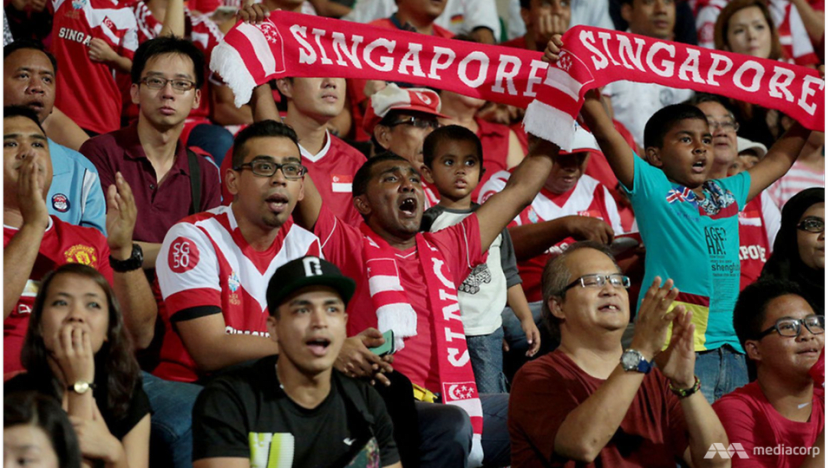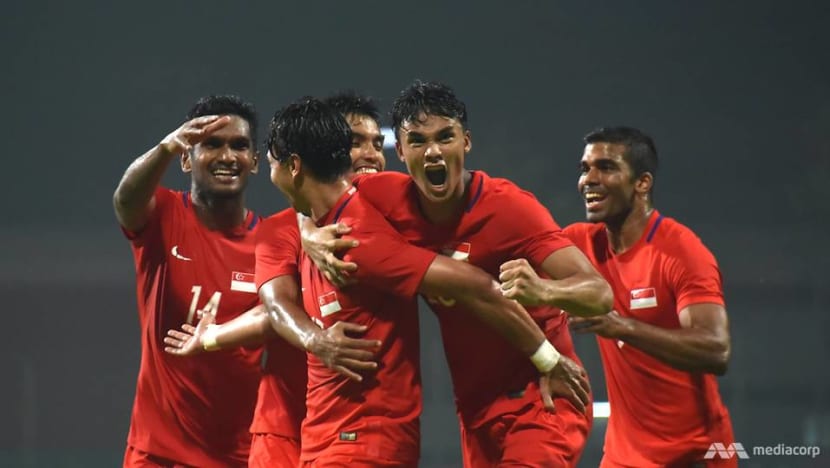commentary Commentary
Commentary: Let the children play - Singapore's 'best chance' to achieve football success starts in its schools
The new 2034 World Cup goal will yield enormous benefits if we put our hearts and minds to it, says Football Association of Singapore Deputy President Bernard Tan.

Fans supporting Singapore's national football team
SINGAPORE: Modern football is today played at a tempo and intensity that was unimaginable in the 1970s. Top end players regularly clock 11km of running and complete over 60 sprints in a 90-minute game.
In a 1972 study on Everton – way before Opta statistics became a feature in football - Dr Thomas Reilly from John Moore’s University calculated that the average player only ran 8.68km per match.
This almost 30 per cent increase in distance run is certainly paralleled in the number of sprints as well.
Top teams move the ball at such a high tempo that they can regularly complete over 600 passes in a game, also nearly 30 per cent more than before.
The pressing and counter pressing that modern teams employ has restricted time on the ball so much that players pass and move almost by instinct.
Where size and strength were the determinants of good footballers in the long ball game of yesteryear, today’s possession-based game requires players who are built around speed, technique and movement – elements that help mould complete footballers.
This improvement in performance can be attributed to several developments - modern training methods, sports science and psychology, nutrition and improved equipment.
READ: Commentary: Can football deliver Singapore its sporting pride?
But underlying all this is the relentless professionalisation of the game, raising standards everywhere.
If we want Singapore football to perform at top international tournaments, we must devote ourselves to constructing a developmental system that can produce teams and players that can meet the exacting requirements of modern football.
The recently announced national project - Unleash the Roar! - offers a unique opportunity for us to undertake a comprehensive overhaul of how the game is approached in Singapore.
The project has an aspirational goal to qualify for the 2034 FIFA World Cup, although the success or failure of the project will not hinge on this one metric.
This aspirational target is set not only to inspire young dreams, but to place stringent demands on ourselves.
FOOTBALL IN SCHOOL
The road to top level football is long and starts at childhood. The biographies of top footballers tend to start with the fact that they fell in love with the game as a young child of six or seven years old and were encouraged to play as often as they could.
Football is fun and allows them to kick around with their siblings and friends. Cristiano Ronaldo, Megan Rapinoe and Homare Sawa, all FIFA’s Player of the Year awardees, took up football to join their older brothers in play. This is how it begins.
Football is actually an easy game to organise. All that is required are things to mark out the goal posts - cones or school bags generally suffice - and a ball, so long as it is kickable.
Many of us growing up in Singapore would have had experiences with makeshift soccer balls - ranging from tennis balls, used or crushed paper moulded into the shape of a ball and held together by masking tape - and makeshift pitches – void decks, car parks, basketball courts and open areas.

At that young age, football is usually safe. Hard or reckless challenges are unlikely. In fact, many European countries encourage boys and girls to play football together up to the age of 12.
Our challenge in urbanised, land-scarce Singapore is to secure a safe, open place for children to play.
This is why I have consistently advocated getting football back into schools as our best chance.
READ: Commentary: World Cup 2034 may seem like a long shot but Singapore can surely get behind this dream
Schools have open spaces for play and provide a safe environment, the latter important in assuring parents that their children are taken care of while they play football.
Allowing our children to run around and play with each other for a short time after school is something we need to encourage given the pull that modern digital devices exert on them.
In so doing they will bond and create lifelong memories. Most of us who played as kids still vividly remember the childhood friends in our teams.
At this stage, there is no need for complicated set-ups, just a safe playing environment with supervision from a parent, teacher or grassroots coach, and perhaps a football coordinator to identify the more talented players. We simply have to let our kids play.
It is through play that we can achieve two critical fundamentals of a functioning ecosystem – expanding the talent pool and lighting the fire of early elite development.
ACADEMICS AND SPORTING EXCELLENCE
Playing for fun is essential, but at some stage the more talented must take a different path to improve. This is the pathway students must take in the “Let Them Soar” track.
In 1957, Dutchman Johan Cruyff, the best player of his generation, joined the Ajax Amsterdam academy at the age of 10. In 1995, Lionel Messi, the best player of this generation, joined the Rosario academy at the age of eight.
In 2004, a six-year-old Trent Alexander Arnold, joined Liverpool’s academy.

In short, the elite formula seems to be to start early. An elite programme therefore requires a strong commitment from both footballers and parents. There are similarities across Europe.
Most non-residential elite academies have three to four training sessions a week, each lasting two hours. As players enter their teenage years, residential programmes come into the picture - like Qatar’s Aspire or Barcelona’s La Masia.
Here, training intensity is even higher. Players have up to 10 training sessions a week, conducted across five days.
Elite programmes stretch over 40 weeks a year, with 12 weeks of break, and feature a minimum of 35 competitive matches a year. This duration and intensity is something we must match if we are to achieve our goals.
READ: Commentary: The Singapore Sports School crushed Assumption Pathway 32-0. Nothing wrong with that
For young players to succeed, they need to remain disciplined, focused and motivated, including in their academic pursuits. This requires strong support to the player as a whole. The buy-in from parents is also crucial.
For many parents, that buy-in comes with the caveat that sporting excellence must not be at the expense of academic pursuits. As such, in all elite programmes, sporting excellence and academia must go together.
The CEO of Sport Singapore Lim Teck Yin best expressed this when he said that embracing multiple demands is a crucial life skill, and this helps Singapore’s young become more resilient.
These academies need to be led by not only an experienced and qualified football youth coach, but also someone who can also be a life coach for young people.
A SINGAPORE APPROACH
How do we deliver this in a Singapore ecosystem? Centrally, we can support all academies in certain shared services, like sports science and curriculum. Programmes can be delivered both in schools, like in America, or in clubs as in Europe.
Both can co-exist and be complementary in our football development.

Some clubs in Singapore, both professional and amateur, are already doing their part in developing youth talent and we should study where this can be enhanced.
However, it is in the area of schools that we must do more.
My experience as a board member of Singapore Sports School has taught me there are advantages in serving up sporting excellence and academia under a single roof: There can be stronger alignment between the four critical stakeholders – the athlete, parent, coach and teacher.
Problems arising from academic and sporting performance can be handled holistically.
READ: Commentary: Why sports still has a place in Singapore
READ: Commentary: Why success should not be the only factor in deciding what is Singapore’s national sport
There are also logistical advantages for school children, including not having to travel separately for training.
For the school, it is almost certain that school identity and pride will be strengthened considerably by having an elite sports team, as it does with schools in America.
At the beginning of this long journey, let’s look at possibilities and not obstacles. And what of the outcome?
If we fall short of raising the Singapore flag at the 2034 World Cup Finals, but we are left with a vibrant football fraternity, Singaporean children aspiring to reach the pinnacle of the sport, a structure that provides a platform for kids to grow and achieve, our best footballers playing in top leagues overseas, and a national ecosystem that continues to support careers and dreams - we are winners still.
Bernard Tan is Deputy President of the Football Association of Singapore.















